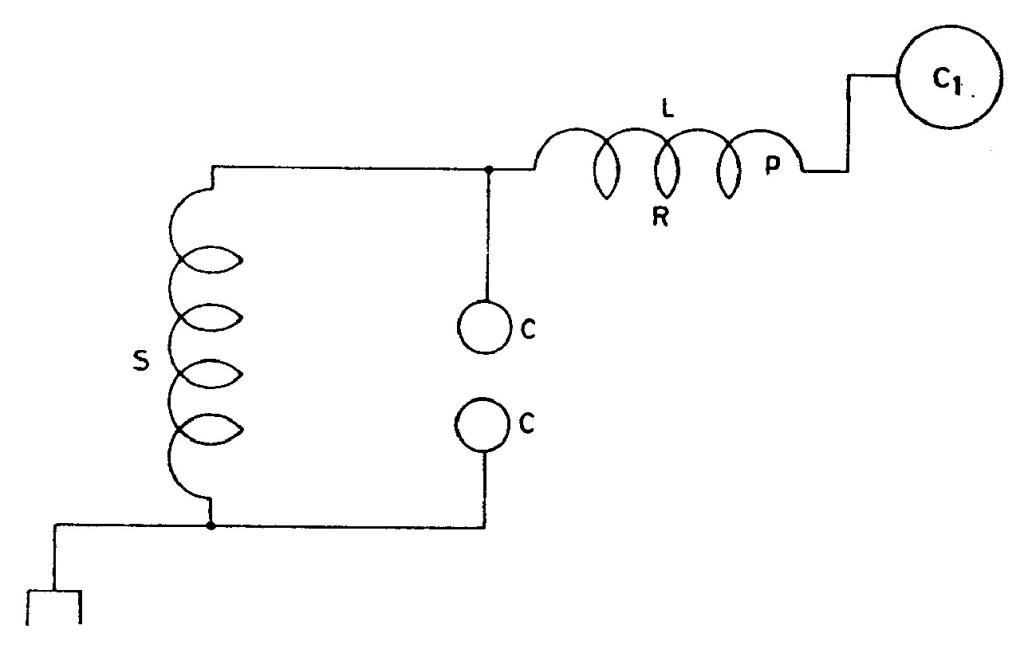
Nikola Tesla Books
Colorado Springs
July 13, 1899
Considerations regarding working of oscillator without spark in secondary. This is a considerable advantage because of economy and also facility of exact synchronous adjustment. When spark used the latter difficult as capacity is changed by varying distance of terminals, also because spark establishes short circuit temporarily. In general, the process is very complicated and the tuning only partially successful. But using spark allows obtaining of great suddenness and using short wave lengths. The shortness of waves gives high e.m.f. and, therefore, great effect at distance. Without spark it is difficult to obtain high e.m.f. with short waves. Long waves on the other hand are less absorbed and allow exact tuning. Following plan seems to offer particular advantages that seemed to work well in New York oscillator.
S is the secondary of oscillator. To this is connected a coil L with capacity C1. The secondary is shunted by a condenser C C. This condenser can be of large spheres when practicable. No spark should go over the spheres C C and streamers should be prevented. Now the adjustment may be such that system L C1 is any upper harmonic. In this system $! {Lp \over R} $! should be as large as possible. The free vibrations of L C1 can be transmitted upon earth through condenser C C.
Colorado Springs
July 14, 1899
Further considerations in regard to producing most effective movement without spark gap in secondary. 2) A way which was experimented with in New York about a year and a half ago and worked exceedingly well and also later with boat, was to produce a very quick primary vibration and induce currents in secondary of a few turns which has
85
July 13
Although short, the note has several interesting data. The effect of a spark in the high frequency oscillator secondary circuit is considered, which reduces the system efficiency, but it has the advantage when it is desirable to produce short waves and high electromotive force.
The schematic shown indicates the oscillator with LC1 circuit for the purpose of high frequency harmonic separation, which Tesla tested in his New York laboratory. He recommends this circuit as the solution for the production of short waves without a spark in the secondary. The capacitor CC for high harmonics frequencies "by-pass" to ground is foreseen in this schematic. A high validity factor of the LC1 circuit is required for the purpose of good filtering.
July 14
He had tried out the devices shown in these drawings earlier on, some of them for wireless remote control of a boat. Patent No. 613809, “Method of and apparatus for controlling mechanism of moving vessels or vehicles” of 8 November 1898 (application field 1 July 1898) mentions the possibility of using electromagnetic resonance but does not give the circuit diagram of the transmitter referred to here.
July 14
These schematics which he provides, he already tested previously, some of them for wireless boat controls at a distance.* The circuit of figure no , l is a "cascade" oscillator. The mercury breaker enables the production of impulses through the coil of first transformer (S1) which charges the capacitor C, and further is Tesla's classic schematic of a resonant transformer with an arcing device D1. The circuit on Figure 2 shows one of Tesla's oscillator variations which is planned for operations with a direct current source supply.
The oscillator of this type is supplied via ballast coil which prevents the source short circuiting via breaker when it is closed and serves the purpose of source energy accumulation. The capacitors are oscillatingly discharged through the closed breaker producing the high frequency current. When the breaker is open, the oscillations in primary circuit stop, capacitors are again charged from the source and accumulated energy in ballast coil. In these instances, the secondary oscillates as dictated by its inductance and capacitance. This circuit in Figure 3 is supposed to enable the use of a long wire in the secondary, when high frequencies are obtained which correspond to LC circuit vibrations. It is not clear how Tesla imagined that by this method, the electromotive forces of any value could be achieved.
* Please see patent No. 612,809 of November 8, 1898, submitted on July 1, 1898(59). In this patent the possibility of electromagnetic resonance use is mentioned, but the transmitter circuit was not given.


